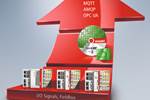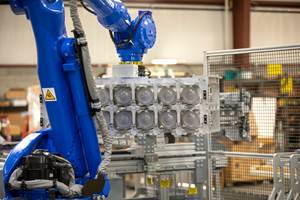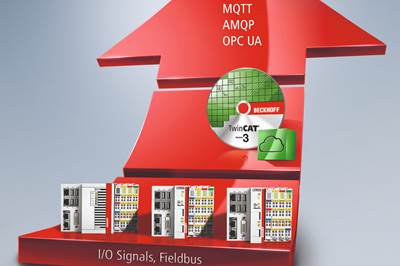Siemens Expands Digital Ecosystem for IoT ‘Transformation’
New open digital business platform aims to make digital transformation for companies of all sizes faster, easier and scalable.

Siemens Process Simulate (left) connects to Nvidia Omniverse (right) for a photorealistic, real-time digital twin of a manufacturing operation. AI and physics-based simulation could help troubleshoot, optimize and run the physical plant. (Image: Siemens & Nvidia)
Siemens AG in Germany has launched what it calls “an open digital business platform to accelerate digital transformation.” It is intended to bring the “Internet of Things (IoT),” also called Industry 4.0, to “customers of all sizes,” the company says. However, the scope of Siemens’ ambitions encompasses entire factories as large as automotive assembly plants, city districts, and transportation systems.
This major expansion of the Siemens Xcelerator program utilizes a growing partner “ecosystem” to deploy “a curated program of IoT-enabled hardware, software and digital services following key design principles of interoperability, flexibility, openness and as-a-service,” Siemens says. The last item refers to “software as a service,” meaning a subscription model that minimizes upfront costs and helps keep apps up to date. The “curated” hardware, software and services have been tested for interoperability; more than 50 partner companies have already been certified to participate in this ecosystem. Another planned element of the Xcelerator program is “an evolving marketplace to facilitate interactions and transactions between customers, partners and developers.”
Siemens says it “will transform its entire portfolio of hardware and software to become modular, cloud-connected and built on standard application programming interfaces (APIs).” The ultimate goal is to “combine the real and digital worlds across operational and information technology.” For instance, Siemens will integrate its industrial IoT (IIoT) solutions under the umbrella of Industrial Operations X, with the intent to accomplish “fusion of data from the real world of automation with the digital world of information technology.”
An example of where this is headed can be seen in Siemens’ brand-new partnership with Nvidia of Santa Clara, Calif., a leader in computer graphics, artificial intelligence (AI), and accelerated computing. The two of them plan to create an “industrial metaverse with physics-based digital models from Siemens and AI-enabled, physically accurate, real-time simulation from Nvidia.” The idea is that together, the partners can create a photorealistic “digital twin” of a factory—even a very large one the size of an auto assembly plant—and have the simulated plant operate under the same physical and mechanical constraints as the equipment in the real one, even running the same operating software for the simulated machines and robots and material-handling equipment. That way, the digital twin can mirror in real time what the real plant is doing. According to Siemens, “This is not animation, but simulation, using data from the actual factory.” This can be used to spot and correct inefficiencies—by human manages or technicians, or by software using AI. Notes Jenson Huan, Nvidia cofounder, president and CEO, “AI allows writing software that no human can”—and testing that software too. “We use digital twins to design and simulate and stress test many kinds of products, so why not factories?” He also noted that “AI must make recommendations that obey the laws of physics.” Using Nvidia’s Omniverse collaborative simulation platform, “The live virtual world, or metaverse, will mimic the physical world in full fidelity and in real time.”
Speaking at the press conference, Milan Nedeljkovic, member of the management board of BMW AG, said BMW aims to realize its “iFactory” vision of the factory of the future by linking existing physical systems one by one into an overall digital twin of an assembly plant. Sensors in the physical plant will feed real-time data to the digital twin. The aim, he said, is for “the digital twin to steer the factory.” According to Nedeljkovic, this is part of BMW’s goal to improve manufacturing operational efficiency 30% by 2025.
Related Content
An Automation 'First' for Non-Servo-Eject Trim Presses
Compact, flexible and configurable robotic system is said to be the first to enable thermoformers to fully automate product handling after a non-servo trim press.
Read MoreSeven Automation Opportunities You May Have Overlooked
While not every process is appropriate for automation, the rapid advancement of robotics is allowing a much wider array of businesses access to this technology. Here are some areas where automation makes sense that you might not have considered.
Read More50 Years...600 Issues...and Still Counting
Matt Naitove marks his first half-century in plastics reporting, with a few of his favorite headlines.
Read MoreEnsuring Repeatability: The Key to Effective Injection Molding Automation
One of automation’s key promises is repeatability: the same movement to the same location, time and time again. But to achieve that, all elements involved — robot, machine, EOAT, mold — must be in and stay in alignment.
Read MoreRead Next
Beckhoff’s Industry 4.0 Products Integrated With Siemens’ MindSphere
The TwinCAT internet of things (IoT) product family can now be integrated with Siemens industrial IoT-as-a-service platform.
Read More






.png;maxWidth=300;quality=90)















